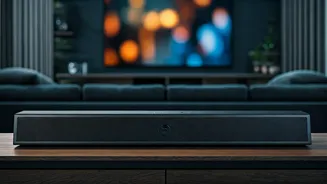Understanding Soundbars
Soundbars have become a popular way to enhance the audio of TVs and other entertainment systems. Unlike traditional speaker setups, soundbars are designed
to be a single, sleek unit, which simplifies setup and saves space. They generally offer a significant upgrade over a TV's built-in speakers. Soundbars typically house multiple speakers within a single enclosure and often incorporate technologies like virtual surround sound to simulate a wider soundstage. There are various types, including those with and without dedicated subwoofers, and models with advanced features like Dolby Atmos or DTS:X for immersive audio. They connect to your TV via HDMI, optical cable, or sometimes even Bluetooth, providing a range of options depending on your needs.
Soundbar Types Explained
The first major consideration is whether to go with a soundbar that includes a separate subwoofer or not. Soundbars with subwoofers offer enhanced bass and overall fuller sound. The subwoofer, which can be wireless or wired, handles the low-frequency sounds, taking a load off the soundbar itself. This is particularly noticeable when watching action movies or listening to music with a strong bass presence. On the other hand, soundbars without subwoofers are simpler, more compact, and can be sufficient for smaller rooms or for users who aren't as concerned about deep bass. Another aspect involves the channels. A 2.1 soundbar includes two channels, left and right, plus a subwoofer. A 3.1 adds a center channel for clearer dialogue, while 5.1 and higher include surround sound speakers. The number of channels determines the depth of the audio experience.
Key Features to Assess
When assessing soundbars, a key feature is the connectivity options. Most soundbars connect to your TV via HDMI, which supports both audio and video, simplifying the setup. Optical cables are an alternative and remain common for older TVs. Bluetooth connectivity is another common inclusion, allowing wireless streaming from your smartphone or other devices. Considering audio formats is also essential. Dolby Digital and DTS are standard formats, while Dolby Atmos and DTS:X offer more immersive, three-dimensional sound. Another feature to evaluate is the power output, measured in watts, which is a measure of how loud the soundbar can get. Consider room size, as larger rooms need higher power. Moreover, consider the design and build quality, which impact both aesthetics and durability.
Soundbar Placement Tips
The placement of your soundbar significantly influences the sound quality. The primary principle is to place the soundbar directly in front of the listener, ideally centered below the TV. This ensures the best sound imaging. For many, placing it on the TV stand is a suitable solution, especially for smaller soundbars. If this is not an option, many models can be mounted on the wall below your TV. When wall-mounting, ensure the soundbar is level and at a comfortable listening height. If your soundbar includes a separate subwoofer, consider its placement as well. Generally, the subwoofer can be placed anywhere in the room, but placing it on the floor, ideally in a corner, often gives the best bass response. Experimenting with placement can fine-tune sound quality.
Budget Considerations
The price range of soundbars can vary significantly. Entry-level soundbars provide basic sound enhancements, often at an affordable price. These are generally a good starting point if you're upgrading from your TV's built-in speakers. Mid-range soundbars offer a better balance of features and performance, including virtual surround sound, improved connectivity, and a more powerful overall audio experience. These tend to offer more advanced features. High-end soundbars come with the best audio quality, often including Dolby Atmos or DTS:X, premium materials, and additional features. While more expensive, they deliver the most immersive audio. Consider how much you are willing to spend and what features are essential to make the right choice.
Testing and Listening
When evaluating soundbars, test the sound quality using various content types. Try watching movies, listening to music, and playing video games. Pay attention to how the soundbar handles different audio frequencies. Listen for clear dialogue, a balanced soundscape, and rich bass. Listen in different settings of the room and from different angles. This provides insight into how the soundbar performs. Consider the ease of setup and operation. Soundbars should be easy to connect to your devices and offer intuitive controls. Take a look at the remote control as well. Consider models with user-friendly features like automatic sound calibration and the capacity to change settings.
















